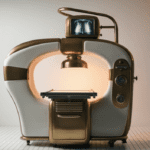Emerging Trends in Radiology – The Use of Artificial Intelligence
A recent article from source-ray inc, states that across the board, when we talk about artificial intelligence (AI), we worry about people losing jobs and we are faced with complex issues related to privacy, ethics, and nuances that only humans can solve for. The radiology field is not different, however, there is a great opportunity. The question is not whether AI technology is coming to radiology but how.
Artificial intelligence is making fast progress in the field of radiology. According to a study by the American College of Radiology, clinical adoption of AI by radiologists has gone from none to 30% from 2015 to 2020.
We’ve come a long way from five years ago when some predicted AI would replace radiologists. Instead, AI is seen as augmenting the radiologist’s intelligence – automating redundancies and optimizing the way radiologists practice. Not just saving time but enhancing the diagnosis and potentially preventing what could have been an easy miss.
AI will become more mainstream in clinical care over the next few years, and it will become an essential part of the diagnostic care process. The industry also foresees AI predictions utilizing multimodal data sources to drive decisions for triage and disease management through the integration of AI within the electronic medical record.
With intelligent workflow, radiologists can practice at the top of their license with maximum efficiency, accelerating their ability to deliver optimal value and enable the best patient care possible. Currently, physicians need to provide feedback to AI to confirm whether it’s correct or not. Improvements will continue to be made as physician feedback trains the algorithms to independently make accurate real-time decisions, but currently, the training for AI will add time on the user end.
Over the next 10-15 years, we’ll see more models become widely available and adopted, with the average radiologists practicing with 20-40 algorithms each depending on their subspecialties. These models will be better able to detect and identify rapidly declining disease states, quantify lesions on previous and current scans, and predict morbidity and mortality from a series of images.
AI can solve some of our most complex and critical health issues. For example, one area ripe for improvement is stroke care. Strokes are the leading cause of long-term preventable disability and cost $100 billion in the U.S. alone. According to an article in the April 2020 edition of Imaging Technology News, there is interest in the development of emerging software tools that can automatically detect large vessel occlusions and send alerts to the appropriate people on a stroke team. There is also excitement about the development of triage mechanisms that can detect brain hemorrhage and bring cases to the top of a radiologist’s worklist.
Some of the goals of AI-enhanced image acquisition are to shorten exam times and decrease the number of retakes while also improving image quality to make difficult-to-identify features easier to spot. With a few FDA-approved technologies and still more pending, this can be an area of significant change if practices are willing to adopt it.
Overall, AI is an exciting area for radiology as new technologies have been shown to accurately identify lung nodules and breast tumors much faster than the human eye. AI can rapidly analyze vast amounts of data, which could improve treatment planning for patients. To move forward with AI, AI companies must engage with physicians and technologists to invest their time in improving AI.
Sources include Imaging Technology News, April 2020
Source-ray inc. Top 3 Trends in Radiology for 2020




